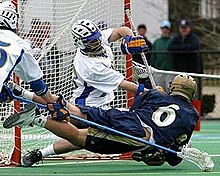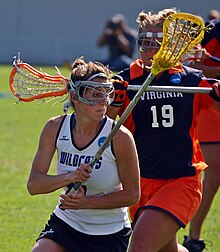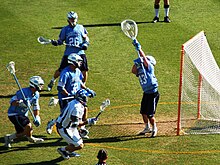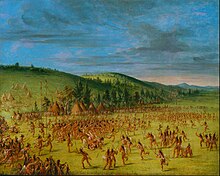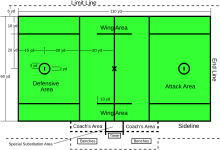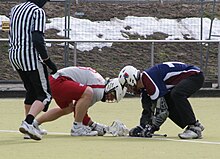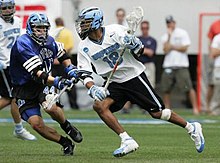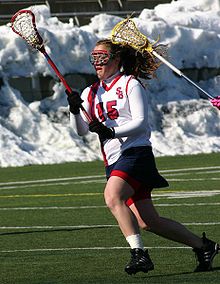lacrosse
Lacrosse is a team sport that is played with a lacrosse racket and a hard rubber ball and is therefore one of the ball sports .
At the Olympic Games in 1904 in St. Louis and at the Games in 1908 in London Lacrosse was a competitive discipline at the Games in 1928 in Amsterdam , 1932 in Los Angeles and 1948 in London only demonstration sport , and then continued to lose importance. Alongside ice hockey, lacrosse is a Canadian national sport .
history
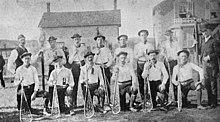
The game originated from the Indians of the East Coast and the Great Lakes , in what is now Canada and the United States . They called it Baggataway or Tewaraathon ("little brother of war") and dedicated it to the god of war. Not infrequently these games, which were played in preparation for wars with other tribes, ended fatally. The games were sometimes played with more than 100 players, and the goal was often a stone or a tree . In addition to preparing team spirit, which was considered necessary for waging war, the game was also used to settle disputes between tribes and other groups.
The game in 1634 by the was first mentioned French Jesuit missionary Jean de Brébeuf in Ontario , which the bat to a bishop's staff reminded of the game and therefore the name of La Crosse was, the French word for bishop's staff.
In the 1850s, whites also began to take an interest in lacrosse. In 1856 the French founded the first club, the Montréal Lacrosse Club . Lacrosse began its triumphant advance in 1867. In that year the Canadian National Lacrosse Association was launched, the number of teams rose from 6 to around 80, and the first club in the USA was also founded. For the first time the game came to England . In 1874 lacrosse came to Australia and in 1878 to New Zealand . In 1879 the umbrella organization was founded in the USA .
The first women's lacrosse game was played at St. Leonards Abbey School in Scotland in 1890 - a nun read about lacrosse and found it was a good sport for the girls she taught. Men's and women's lacrosse was played with almost the same rules without protective gear until the mid-1930s. At this time, the rules of men's lacrosse began to change a lot, while women's lacrosse continued to be played with the original Native American rules. Until around the turn of the millennium, for example, women still played without fixed sidelines - rather a row of trees, the nearest meadow or a bush was used as a guide. Nowadays women and men play lacrosse according to completely different rules. The women's lacrosse rules limit club and body contact, so little protective equipment is required. In men's lacrosse, however, like ice hockey, helmets, rib and shoulder protection and gloves are worn.
At the Olympic Games in 1904 in St. Louis and at the Games in London in 1908 , lacrosse was a competitive discipline for men, at the Games in Amsterdam in 1928 , in Los Angeles in 1932 and in London in 1948 it was in the Olympic demonstration competition.
Afterwards, however, the sport of lacrosse sank into oblivion for a while. Neither the Native Americans nor the Americans and Canadians showed much interest in the sport. It survived only as a college sport at some of the east coast prepschools . It would have stayed that way, because the growth of the sport was limited by a few factors. On the one hand, due to its character of being a "sport of the elite", the sport was only accessible to a small segment of the population, on the other hand there were only a few Indians who were trained in the art of making lacrosse clubs. It was only with the introduction of the plastic club head that lacrosse became accessible to a wider public. In 2007 around 47,000 Canadians played a variant of lacrosse, mainly played in Canada, called box lacrosse. Much more successful is Inter Crosse, which men and women play together and which is played without contact. It is played by 250,000 Canadians in 45 countries worldwide.
In 1987 the National Lacrosse League (NLL) was founded. Here nine teams from four Canadian and five US cities compete against each other. In the past seven years, the Rochester team has been the most successful with three championships. There have been U-19 lacrosse world championships since 1988 . In 1994 the Canadian Parliament made lacrosse a national sport. The USA defeated Canada at the World Cup in Perth , Australia . The 2006 World Cup took place in London, Ontario. The Major League Lacrosse has existed as a men's professional league in the USA since 1999 (game operations since 2001) . Older is the indoor lacrosse league in North America, which operated under the name Major Indoor Lacrosse League (MILL) until 1997 and is now called the National Lacrosse League . It was founded in 1986. The European Lacrosse Championship was first held in 2004. The indoor or indoor world championships have been held every four years since 2003 .
The women played under the aegis of the International Federation of Women's Lacrosse Associations, founded in 1972. The Americans are in the lead here. The association now has ten international teams.
Rules of the game
General
The game is played on a 45 m wide and 102 m long field. The goal is 1.83 mx 1.83 m and, similar to ice hockey, is not located at the end of the field, but 14 m in front of it. The ball is made of hard rubber , has a circumference of 20 cm and weighs approx. 140 g. He is caught, carried and thrown with the bat. The racket, called Crosse or stick , is 101-183 cm long and not thicker than 2.5 cm. The club head is usually made of plastic, but can also be made of wood or laminated wood. A net, the so-called "pocket", is tied in the club head, which should enable precise passing and ball control at the same time. The shaft is made of either wood , aluminum , titanium or carbon fiber reinforced plastic .
The men play 4 × 20 or 4 × 15 (American leagues) and the women 2 × 30 minutes.
Game flow
The game starts with a face-off for men and with a so-called draw for women. During the face-off, the two players of the teams performing the face-off kneel or crouch opposite at the center and after the whistle try to win the ball or pass it to one of their teammates. In the ladies' draw, the ball is clamped between the two clubs of the executing players and thrown into the air when the whistle starts. During the game the ball can be carried as long as you like; so there is no rule when a ball should be passed. The attacking team changes when the opposing team has captured the ball. At any time, a defending player is allowed to hit the opponent's stick with his own stick to get the ball free. For men, the contact between the players is part of the game, which is why they are allowed to separate or keep the opponent away from the ball with physical effort. Women's lacrosse, on the other hand, does not use a lot of physical activity, which is why the women are only allowed to “stroke” the opponent a little. The aim of the game is to score more goals than the opposing team.
Men's lacrosse
equipment
- The bat
The lacrosse stick (stick) is made of wood, laminated wood or synthetic material and has a shaped, pocket-like net (pocket) at the head end. The stick must have a total length of 102 to 107 cm for attackers and midfielders, while the length for defenders is 132 to 183 cm. The club head must be 17.5 to 25.5 cm wide. A pocket does not meet the rules if the topmost point of a ball in the pocket is below the bottom of the club head frame.
- The ball
The ball is made of solid rubber and can be white, yellow or orange in official games. The ball has a diameter of 60 to 75 mm and weighs 142 to 149 grams.
- The helmet
The helmet with protective grille is held in place by means of a 4-point attachment that starts from a shaped chin piece and must be worn by all players. All helmets and guards should be certified by NOCSAE, the National Operating Committee on Standards for Athletic Equipment. Helmets bought in Europe must also have CE certification. Wearing a helmet is compulsory.
- The gloves
All players must wear protective gloves. Changes to the gloves are prohibited.
- protective gear
Typically, most players wear elbow guards, shoulder guards, and mouthguards (all three are mandatory in US leagues). Furthermore, the wearing of a groin guard and rib protectors is recommended for all players.
Team and players
A team consists of up to 23 players (any number under NCAA rules). During a game, a maximum of 10 (in the indoor version 6) players may be on the field at the same time. Usually these consist of 3 attacking players, 3 midfield players, 3 defense players and a goalkeeper. The players are free to switch between the two sides of the field. It must only be ensured that at least 3 players of a team are represented on the opposing side and 4 players (including the goalkeeper) on their own side of the field (offside rule), the actual position is not important. Z. If, for example, a defender or the goalkeeper crosses the center line, a midfielder or attacker must remain behind. Each team must designate at least one captain who does not have to wear an identification symbol. The substitution of field players is not only possible during game interruptions, but can also be done "on the fly".
Positions
- Attackers: There are three attackers on the field at once. They use a short stick , the normal lacrosse stick . The attackers should have good stick skills, as they mostly have the defender as an opponent. They should also have the ability to see the game as a whole and to know where the other players are.
-
Midfielders: There are 3 midfielders on the field at the same time. They are divided into offensive and defensive midfielders. They are the most agitated players on the field, which means that they are often replaced. The midfielders carry the ball into the opposing zone and try to build the attack there. In defense, they usually take over the opposing midfielders. They mostly do the face-off.
- Fogo: (English: Face-off, Get-off) is a midfielder who is only used during the face-off to carry it out. He will then be substituted as soon as possible. This is widespread in American college sports, but less common in other leagues, as the face-off specialists are otherwise good players and you don't have such a large selection of good substitutes.
- LSM: A midfielder can receive a long stick (LSM = Long Stick Middie). This is a tactical maneuver to be able to defend better. A total of only up to four long clubs per team may be on the field at the same time. The LSM is usually replaced in attack by a midfielder with a short stick. Nevertheless, in addition to good defensive skills, he also needs good stick control, as he has to run counterattacks or get involved in the attack.
- Defense : There are three defenders with long sticks. Defenders used their big stick to check the opponent in all forms and thus prevent goals and provoke the opponent to lose the ball.
- Goalkeeper (Goalie): The goal of the goalkeeper is to protect your own goal, i.e. to stop the opponent's shots. The goalkeeper is responsible for organizing the defense and supports you e.g. B. by announcing the ball position. The goalkeeper should have a clearly audible voice in order to be able to coordinate his teammates correctly. Furthermore, he should have physical and psychological strength and also good reflexes, as he should be able to stop the ball, which can go over 160 km / h, without injury through quick movements.
Punish
Penalties are given by the referees. A distinction is made between technical and personal fouls. The penalty for a technical foul is either possession of the ball for the fouled team or a 30-second time penalty (if the fouled team already has possession). A personal foul always results in a time penalty of 1, 2 or 3 minutes. The principle applies: "what begins legally, ends legally". This means that if an opponent turns away shortly before contact and is therefore pushed, for example, from behind, this is not a foul. Particularly serious fouls can also be punished with the exclusion of a player from the game. This may then be replaced by another player on the team after 3 minutes. If a player has committed 5 personal fouls, he is fouled out, which equates to the exclusion of the player. A player who has committed an exclusion foul will be banned for at least one further game in Germany, in contrast to a fouled out.
Personal rule violations in men's lacrosse (personal fouls)
- Checking the body with the stick (cross checking): If a player attacks the body of the opponent with his stick , the hands must be kept so close together that the opponent cannot be touched by the stick shaft between the hands.
-
Illegal Body Check:
- Violation of the rules when an opponent is attacked while he is neither in possession of the ball nor within 5 feet of a ball on the ground.
- Violation of the rules if a check against an opponent who was previously in contact with the ball and who has already passed or shot the ball could have been avoided.
- Violation of the rules when the opponent is checked from behind or below the hip.
- Violation of the rule when the opponent is checked above the shoulder. A body check must be carried out between the shoulder and hip area and both hands must grip the club shaft.
- Illegal slashing: Violation of the rules when the player's stick hits the opponent hard or deliberately in an area outside the stick or gloves.
- Tripping: Violation of the rules when a player trips or falls over his opponent by touching any part of his body or equipment.
- Unnecessary Roughness: Violation of the rules when a player hits his opponent with excessive or inappropriate harshness.
- Unsportsmanlike Conduct: Violation of the rules when a player or coach performs an act that is deemed unsportsmanlike by a referee, such as B. Excessive discussion, ridicule, and obscene language or signs. It is also unsporting behavior if a player uses a club that does not comply with the rules. A club breaks the rules if the pocket is too deep or if other parts of the club have been improperly altered to gain an advantage.
The flags are a specialty of lacrosse. If a fouled player remains in possession of the ball, the referee does not interrupt the game, but throws a penalty flag . The interruption (by whistle) does not take place until the attack has been completed.
Technical rule violations in men's lacrosse (technical fouls)
- Entry into the goal circle (crease violation ): Rule violation if a player of the attacking team enters the circle around the goal (crease) or a defensive player carrying the ball, including the goalkeeper, enters his own goal circle from the surrounding field of play, with the exception of a foul leads to entering the circle.
- Holding: Violation of the rules if the movement of the opponent carrying the ball is impaired in an illegal manner (e.g. by holding on).
- Illegal Block (Illegal Offensive Screening): Violation of the rules when a moving offensive player touches a defensive player (not playing directly against him) through his body or equipment and thereby impairs his movements.
- Interference: Violation of the rules when a player interferes with his opponent's freedom of movement in any way, even though the opponent is not in possession of the ball, nor is within four feet of a ball in the air or on the ground.
- Offsides: Violation of the rules if a team does not have at least 4 players in the defensive half or at least 3 players in the attacking half of the field of play.
- Pushing: Violation of the rules when a player pushes or pushes his opponent from behind.
- Time wasting (stalling): Violation of the rules when a team deliberately holds the ball outside the attacking zone without aiming to play on the opposing goal, thus wasting time. The time wasting is preceded by a warning to bring the ball into the attack zone and keep it there (bring it in, keep it in).
- Delay of Game: Violation of the rules if a team unnecessarily postpones the restart, e. B. if a player throws the ball away, a team does not take the face-off position in time or no player takes the ball at the restart.
Women's lacrosse
equipment
- The bat
The lacrosse stick is made of wood, laminated wood or synthetic material and has a shaped, pocket-like net, called a pocket, at one end. The racket must have a total length of 90–110 cm. The head has a width between 18 and 23 cm. The women's pocket is braided from straps and ribbons, as the mesh material used by men is only allowed for goalkeepers and men. The top of the ball in the pocket must not be lower than the top of the racket frame.
- ball
The ball must be yellow and made of solid rubber. A legal ball should be 60 to 75mm in diameter and weigh between 142g and 149g.
- Mouthguard
The face mask is compulsory for all players.
- Voluntary protective equipment
Tight-fitting gloves and protective goggles may be worn by all players, but are not mandatory.
Teams and players
There are twelve players on the field during a game. As a rule, these consist of three attacking players, five midfield players, three defense players and a goalkeeper. As with the men, the midfield, defense and attacking players may change positions at will, but no more than eight players from each team may be in the outer third of the field, behind the so-called restraining line, at any time. Each team has one or more captains, as with the men, they do not have to wear an identification symbol. Field players may be changed continuously during a game.
Rule violations
Major fouls
- Blocking: Violation of the rules when a defender gets in the way of an attacker carrying the ball in such a way that she has no chance to evade and physical contact occurs.
- Charging: Violation of the rules when a player throws herself into an opponent, jostles with the shoulder, runs backwards into the opponent or pushes her with hands or body.
- Dangerous shot: Violation of the rules if a player throws uncontrollably towards the goal and endangers the player and / or goalkeeper.
- Misconduct: Misconduct occurs when a player plays in a grossly unsporting or dangerous manner, constantly breaks the rules or deliberately endangers the safety of the opposing players.
- Uncontrolled hitting (Dangerous Check): Violation of the rules if a player swings her stick in the direction of the opponent and thereby deliberately endangers the safety of the opponent, regardless of whether she hits the stick or the player's body.
- Obstruction of Free Space: Violation of the rules if a defender does not cover her opponent (who is not in possession of the ball) closely enough and stands in the way of the attacker in possession of the ball. This rule only applies if the attacker has the opportunity to shoot at goal and is looking for it.
- Three seconds rule: A defender may not stand in an 11 m semicircle in front of the goal for more than three seconds, unless she covers an opponent within one meter.
Minor fouls in women's lacrosse
- Body ball: A ball that ricochets off the body and gives the player or team an advantage.
- Goal circle rule violation: rule violation if any part of the body or stick of any player (attack, defense or midfield) with the exception of the goalkeeper or his deputy enters the goal circle.
- Illegal defense (warding off): Violation of the rules if a player jams a ball lying on the ground with her foot or bat, removes one hand from the bat and uses her free arm to defend the opponent.
- Checking a bat without a ball (Empty Crosse Check): A player is not allowed to check an opposing bat if she is not in contact with the ball.
Positions
attack
- First Home: The first home player's job is to score goals. The player is positioned directly in front of the goal and must constantly try to run free in front of the goal or to move away from the goal to make room for other players. The first home player should have very good ball and racket control.
- Second Home: The second home player supports the first home player. The player should be able to shoot hard and precisely from any angle.
- Third Home: The third home player's job is to pass or carry the ball from defense into attack. She should be able to play precise passes and move up into the wings.
midfield
- Attack Wings: The task of the wingers is to carry the ball from defense into attack. You should be quick, have good stamina and, if you win the ball, you should be ready to defend yourself in order to carry the ball forward or pass it.
- Center: The center player's task is to perform the "draw" (a maneuver in which the ball is placed between two players' clubs at the start of the game or after goals), and to play defense and attack. It has to be very quick.
- Defense Wing: The defending wingers cover the attacking wingers and bring the ball into the attacking zone. You should have speed and stamina.
defense
- Point: The point player is the last instance before the goalkeeper, she usually plays a crease defense. She covers the first home player of the opposing team and should be able to check with the bat and intercept passes.
- Coverpoint: The Coverpoint player covers the second home player. She should be ready to play for balls won in defense, run fast and show good footwork.
- Third Man: The third man player covers the second home player. She must be able to intercept passes, carry the ball from defense into attack or pass and run fast, and have good footwork.
- Goalkeeper: The goalkeeper stands in the goal and "protects" it. The player should have good ball and racket control, courage and self-confidence as well as quick reflexes.
referee
There are usually four referees on and off the pitch. They are divided into a main referee, two additional field referees and a CBO (bank referee). The referees have control over the players and coaches. All four pay attention to security risks and rule violations and are allowed to whistle. The CBO is limited in this: it only pays attention to the penalty times, substitution errors and supports the monitoring of the offside rules. He may not whistle for other violations that he noticed, but inform the other referees. A fifth referee is often used as a substitute referee. This is called the bank manager (BM) and supports the CBO, but is not allowed to punish any rule violations. In addition to the referees, there are timekeepers and scorers who, on the one hand, stop the playing time and the penalty times and, on the other hand, write down the goals with their assists.
organization
At the international level, the umbrella organization Federation of International Lacrosse (FIL) stands for men's and women's lacrosse. This organizes a lacrosse world championship every four years for men or women (time-shifted). The FIL has 27 national associations. Despite its Olympic past, lacrosse is no longer one of the sports recognized by the IOC, and the FIL is also not a member of the world sports association Sportaccord . Most of the national lacrosse organizations do not belong to the respective sports umbrella organizations.
Individual countries
Germany
After Germany came Lacrosse until 1993, as an exchange student from the United States in Berlin and Munich clubs founded. There are now three men's leagues, four women's leagues and two junior leagues organized under the umbrella organization, the German Lacrosse Association (DLaxV). In 2014/2015 the following men's teams play in the league:
- The Bundesliga North / East includes regular match operations in the north and east of Germany and is divided into the 1st Bundesliga North / East, the 2nd Bundesliga North and the 2nd Bundesliga East. Six teams compete in the 1st Bundesliga North / East. These are the DHC Hannover A, the USV Dresden Braves A, the Bielefelder TG Hawks , the HTHC Hamburg Warriors A, the Berliner Hockey Club A and the SCC Blax A. The Lacrosse Club Kiel and the Bremen Likedeelers play in the 2nd Bundesliga North , the HTHC Hamburg Warriors B, the syndicate DHC Hannover B / Braunschweiger THC , the East Coast Shellbacks (syndicate from Lübeck and Rostock), the Osnabrück Peacekeepers and the Göttingen Grasshoppers. Victoria Lacrosse Berlin, as well as the syndicates Berliner Hockey Club B / Dresden B, SCC Blax B / Cottbus and Halle / Leipzig / Erfurt A & B. play in the 2nd Bundesliga East.
- The following seven teams play in the 1st Bundesliga West: Aachen Lacrosse A, SC 1880 Frankfurt Lacrosse A, Schwarz-Weiß Köln Lacrosse A, Düsseldorfer SC 99 , Marburg Saints , Münster Mohawks A and Mainz Musketeers. The 2. Bundesliga West is divided into two leagues. Bochum Lacrosse, HC Kassel Raccoons , Paderborn Hornets, Dortmund Wolverines , Essen and Münster Mohawks B play in the north-east. In the south-west, the Kaiserslautern Lumberjacks, Frankfurt B, Aachen B and the Cologne / Bonn and Saarbrücken / Trier syndicates play .
- The Bundesliga South consists of the 1st Bundesliga South and the regional leagues of Bavaria and Baden-Württemberg. In the 1st Bundesliga South, HLC Rot-Weiß Munich A, ABV Stuttgart A, Karlsruhe Storm KIT SC 2010 A, FT Würzburg, Erlangen Tribesmen play , Tübingen Lacrosse A and PTSV Jahn Freiburg A. The regional league Baden-Württemberg is made up of the following teams: SG Friedrichshafen / Konstanz, Rhein-Neckar Lacrosse B, Tübingen Lacrosse B, ABV Stuttgart B, and PTSV Jahn Freiburg Pumas / Karlsruhe Storm B. The Bavarian regional league is made up of the following teams: HLC Rot-Weiß München B & D, Spielgemeinschaft Bayreuth / Erlangen B, HG Nürnberg Wizards, TSV Ingolstadt Panthers, and Passau.
The first four from the 1st Bundesliga North / East and the first two from the 1st Bundesliga West and the 1st Bundesliga South go into the playoffs, in which the best four are determined in a so-called " double elimination round". The best four then play the German championship in the knockout system .
Women's League:
- The women's Bundesliga North is divided into the 1st Bundesliga North, in which the HTHC Hamburg Warriors A , Bielefeld TG Hawks , DHC Hannover A, ATS Buntentor Bremen and HTHC Black Pearls play, and the 2nd Bundesliga North, where the teams from the Lacrosse Club Kiel, the Lübeck / Rostock syndicate and the B-teams from the HTHC Hamburg-Warriors and the DHC Hannover play in a syndicate with the BTHC Braunschweig.
- Two teams from SCC Blax , Victoria Lacrosse , the Dresden Braves and the community of players from Cottbus, Leipzig, Jena and Halle play in the women's Bundesliga East .
- SC 1880 Frankfurt Lacrosse, Münster Mohawks, the Düsseldorf Hirschkühe, the Mainz Musketeers and the Cologne Indians play in the 1st women's Bundesliga West . In the 2nd Bundesliga West, the DoPa Donkeys team and the Cologne / Bonn / Aachen, Kassel / Osnabrück / Essen and Marburg / Göttingen gaming communities compete against each other.
- HLC Rot-Weiß München A, PTSV Jahn Freiburg, Karlsruhe Storm Lacrosse, Würzburg Lacrosse and ABV Stuttgart Lacrosse play in the 1st Women's Bundesliga South . In the 2nd Bundesliga South are HLC Rot-Weiß München B, Kaisar, Lacrosse Verein Heidelberg, Tübingen and the game communities Passau / Friedrichshafen / Nuremberg / Regensburg and Konstanz / Mannheim.
Juniors: There has been a junior league in Germany since 2007, the DLaxV Junior League. In it play: HTHC Tomahawks, Düsseldorfer SC 99 Antlers, Bruessel Lacrosse, Stuttgart Lacrosse, SC 1880 Frankfurt Lacrosse, Schwarz-Weiß Köln Lacrosse, Berliner Hockey Club, DHC Hannover and the Südmix, HTHC Hamburg Warriors.
Austria
The foundation stone for lacrosse in Austria was laid in 2001 with the founding of Salzburg Arizonas. Four years later, on November 10, 2005, the Austrian Lacrosse Association (ÖLaxV) was founded. Just one year after it was founded, the Austrian Lacrosse League (ÖLL) began to be organized, in which teams from Austria's neighboring countries also take part. In order to attract players, recruitment through lacrosse courses at the universities of Vienna, Graz and Innsbruck began in 2005.
In 2012 the following men's teams were in the ALL: Vienna Monarchs , Graz Gladiators , Vienna White Coats, Carinthian Celtics and, as guest teams from Hungary, Budapest Blax. The Eisenstadt Steelers team from Burgenland is under construction, as is the Waldviertel Lacrosse Team and the Innsbruck Eagles. The women's championship is contested by the Graz Gladiators, the Vienna Monarchs and Vienna Cherokees as well as the Bratislava Tricksters from Slovakia.
Switzerland
The Herzogenbuchsee Iroquois Lacrosse, Wettingen Wild Lacrosse, Bern Titans, Zurich Lions Lacrosse, the St. Gallen Sunnyboys Lacrosse Club, the Basel Spartans and the mixed team from Friborg / Olten / Lucerne (from the 2011 season the Olten Saints, Lynx Lacrosse will play Lucerne and the Freiburg Skunks separately) and Wizards Sports from Winterthur are organized in the Swiss Lacrosse Association (SwissLaxV). For the 2010 season, the Friborg Skunks will part ways with the mixed team and KSC Chur will join the SwissLaxV. In the third season after 2008 and 2009, 9 teams are fighting for the Swiss championship title, after the Zurich Lions won the title in the first two years. The SwissLaxV is a member of the European Lacrosse Federation (ELF) and the Federation of International Lacrosse (FIL). The SwissLaxV promotes the spread of field lacrosse in Switzerland and sends the national team to the international lacrosse competitions of the ELF and the FIL.
The Swiss Lacrosse and Intercrosse Association ( SLIV ) is currently under construction. At the moment there are five teams in the SLIV: Blackhawks Kriens (has disbanded), Red Monkeys Rothenburg (has disbanded), Green Buzzard Rickenbach, Hurricanes Herzogenbuchsee and Aquillas Basel. The Swiss Games take place once a year.
Canada
Alongside ice hockey, lacrosse is a national sport in Canada (although Canadian football is more popular with viewers ). Since the country was founded, sport was an official national sport until the government tabled a bill declaring ice hockey a national sport . In 1994, First Nations stakeholders objected to this bill. They argued that doing so would lose the cultural and historical significance of lacrosse. Since May 12, 1994, lacrosse has been the official summer national sport and hockey has been the official winter national sport. The Canadian Lacrosse Association organizes women's, men's, boys 'and girls' lacrosse games . The men's national championship is known as the Ross Cup and that of the women is known as the Robertson Cup . The men's national team has won the world championship three times so far.
The indoor version Boxlacrosse is more popular than the field version. These games are played in ice hockey stadiums, the ice surfaces of which have been defrosted or covered with artificial turf. The most important tournament is the National Lacrosse League , in which teams from the USA and Canada participate. Outstanding field and indoor players are inducted into the Canadian Lacrosse Hall of Fame .
Important awards
The following awards are some of the most important in lacrosse:
- the Tewaaraton Trophy
- the Lt. Raymond Enners Award
- the Jack Turnbull Award
- the William C. Schmeisser Award
- the Ensign C. Markland Kelly, Jr. Award
- the National Lacrosse League MVP Award
See also
- Intercross (trend sport without physical contact and "mixed")
- Polocrosse (combination of polo and lacrosse)
literature
- Vincent Perez-Mazzola: The Lacrosse Training Bible: The Complete Guide for Men and Women . Hatherleigh Press, ISBN 978-1-57826-249-6 .
- David G. Pietramala, Neil A. Grauer: Lacrosse: Technique and Tradition . Johns Hopkins University Press, ISBN 0-8018-8410-1 .
- Jim Hinkson: Lacrosse Team Strategies . Warwick Publishing, ISBN 1-894622-48-0 .
- Neil Duffy: The Spirit in the Stick . Duffy Publishing, ISBN 0-9753686-0-5 .
- Thomas, Jr. Vennum: Lacrosse: Little Brother of War . Smithsonian Books, ISBN 1-56098-301-9 (published in German as: Thomas Vennum. Das Indianische Lacrosse-Spiel . Baum Publications, ISBN 3-930596-03-2 ).
- Maud C. Hietzge: Handbook for Lacrosse and Intercrosse: Game Structure - Technique - Training . Meyer & Meyer Verlag, March 2009, ISBN 978-3-89899-275-6 .
Web links
Individual evidence
- ↑ http://www.olympic.org/uk/sports/recognized/index_uk.asp
- ↑ Archived copy ( memento of the original from January 18, 2015 in the Internet Archive ) Info: The archive link was inserted automatically and has not yet been checked. Please check the original and archive link according to the instructions and then remove this notice.
- ↑ Archived copy ( memento of the original from January 18, 2015 in the Internet Archive ) Info: The archive link was inserted automatically and has not yet been checked. Please check the original and archive link according to the instructions and then remove this notice.
- ↑ http://www.pointstreak.com/prostats/standings.html?leagueid=1533
